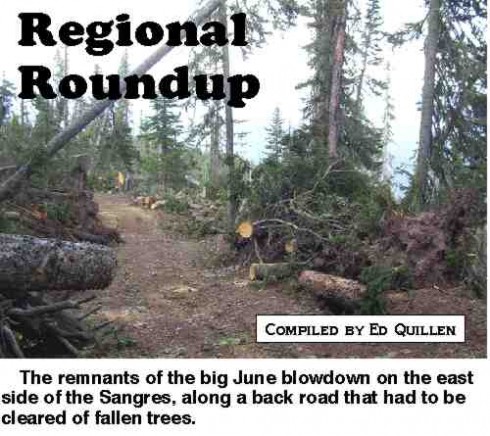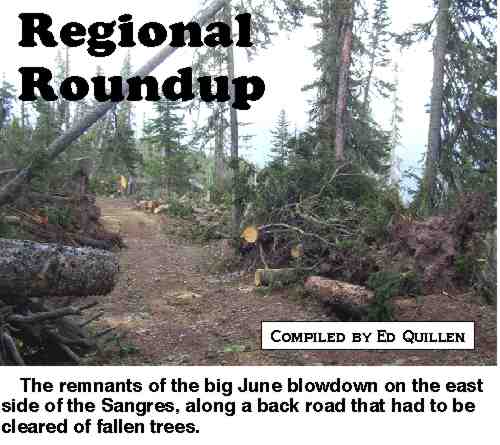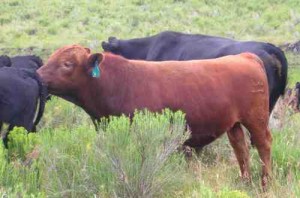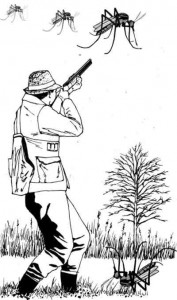Brief by Ed Quillen
Local News – August 2007 – Colorado Central Magazine
Strange Winds
We get plenty of wind in Central Colorado, but seldom a tornado. However, a funnel cloud was spotted in Custer County on June 29, and it touched down briefly at 3:55 p.m. without causing any damage.
Mountains do not prevent twisters. “You can get a tornado anywhere in the country, according to Tom Magnuson of the National Weather Service in Pueblo. “There’s no magic about mountains and no mountains.”

That wasn’t the only serious wind in Custer County this summer. In June, high winds toppled many mature spruce and fir trees between Deer Peak and Greenhorn Mountain. The U.S. Forest Service said wet ground made the trees vulnerable to the gales, and several roads were closed on account of the big blow-down, the first in more than 30 years.
A strong gust or “microburst” hit Buena Vista on July 1, toppling a tree onto a house and damaging the roof so much that it was declared uninhabitable. The town also suffered a minor flood on July 5, when a thunderstorm dumped about 1.25 inches of water in a short period. Several basements were flooded, and some buildings were evacuated. No injuries were reported, although several people said they understandably felt frightened while the water was rising in the streets
Tank Town Needed?
This summer, the Rio Grande Scenic Railroad began running a steam locomotive on weekends and holidays between Alamosa and La Veta. The locomotive turned about 6,000 gallons of water into steam in the process, and its tender was refilled in La Veta for the return trip over La Veta Pass.
However, the town’s water commissioner discovered that the locomotive water was coming from an agricultural water right. Under Colorado’s complex water law, such water has to be used for agriculture, and can’t be used for something industrial, like a steam engine.
The town and the railroad have worked out a temporary deal on water supply for the rest of the operating season, which ends in October. And there’s a fallback. The RGS can send over a full tank car of water — 20,000 gallons — on one of its freight runs before the weekend steam train. That’s more than enough to fill the tender on Saturday and Sunday, and another freight can return the tank car to Alamosa for a refill.
Exporting Water?
Back when the Arkansas River ran orange every now and again because some mine drainage got loose at California Gulch, we used to joke that we could get rich selling “Heavy Metal Water.”
But it’s no joke that Nestle Foods is interested in acquiring some mountain water to bottle for its Arrowhead brand. In Chaffee County, the company is looking at springs near Nathrop, now used for a private fish hatchery. The company has already purchased 112 adjacent acres to use as a buffer zone to protect the water’s purity, but wants to conduct further studies on how dependable the springs are.
Presumably the water would be trucked to a bottling facility elsewhere, so it wouldn’t mean much in the way of local jobs. And then there’s the prospect of several years of litigation in water court to insure that senior water-rights holders are protected from this consumptive use.
Big Brother on the Farm
If you follow agricultural news at all, you’ve probably heard of NAIS — the National Animal Identification System. Every head of livestock is supposed to be tagged, owners must register, and detailed records are to be kept of breeding, transportation, etc. It was about as popular as an anthrax epidemic among small producers, and earlier this year, the U.S. Department of Agriculture announced it would be voluntary, not mandatory.
However, it has become mandatory for one group: 4-H kids who want to show their animals at the Colorado State Fair in Pueblo this year. This has led to protests in some places, among them Park County, where the county commissioners sent a letter of opposition to the relevant agencies, and assured people that NAIS would not be used at the county fair. “We choose not to subject our youth to this program of requiring registration.”
In theory, NAIS is supposed to help track outbreaks of disease or food contamination. So we can’t wait until the U.S. government applies it to China, and sensibly lets 4-H critters get sold at the fair; after all, the buyer knows where that meat came from and how it was raised. Given the choice of trusting the feds, or a local 4-H kid, the answer seems like a no-brainer.
Now for some dirt
The Federal Aviation Administration told the Lake County Airport that it had to remove some dirt for safety reasons. Platinum Environmental, a contractor working remediation at the old Arkansas Valley Smelter site on the west side of Leadville, needed dirt to cover some slag piles.
Such a beginning often leads to a tale of the county paying to have the dirt hauled off, while the contractor imports dirt at considerable cost, but that’s not how this ended. Lake County and Platinum Environmental came to a quick agreement that saved both of them money — Platinum will haul the dirt away from the airport at no charge, and use it to cap the slag.
This sort of arrangement should not be so rare as to be noteworthy. Something similar happened a few years ago in Frémont County. The county needed gravel for improvements on the Cotopaxi Cut-off Road, and the contractor for a new school in Cotopaxi needed to haul off the excavated gravel. The trade was made.
Population explosions
Every so often, in reading about the early days of Colorado’s highest mining towns, there’s a reference to the “cat-line.” This did not refer to the line of cat-houses in the red-light district, but was analogous with “timberline.” Just as there is an altitude where trees couldn’t live, there was also supposed to be an altitude too high for cats.
Visiting journalists cited both Cripple Creek and Leadville as above the cat-line. But if that ever was the case in Leadville, it’s certainly not true now. In its July 12 edition, the Leadville Herald-Democrat reported that the Lake County Animal Shelter had been “overrun with cats and kittens” for about a month, and “people needing to surrender their cats have been placed on a waiting list” because “adoptions have been slow.”
On the other side of the Divide, Gunnison neighborhoods have reported an over-abundance of prairie dogs. The rodents are cute and interesting, but they can also carry plague, and they’re hell on gardens.
Development in and near town has pushed the critters into tighter quarters on vacant lots near the hospital and the community center, and development has also displaced their predators, like snakes, hawks, and eagles.
There was considerable discussion as to whether the population should be thinned by extermination or relocation. In 2004, several environmental groups petitioned the federal government to list the Gunnison prairie dog as an endangered species, on account of its decreased habitat. The U.S. Fish & Wildlife Service denied the petition in 2005.
On the brighter side of animal populations, at least for anglers, “the fish population as a whole [Gunnison and Taylor rivers] was very good, very healthy,” according to Dan Branch of the Colorado Division of Wildlife. A sampling near Almont last fall showed 7,000 brown trout and 780 rainbows per river mile.
Thanks to some hatchery breeding programs, the rainbows have made a comeback from whirling disease, while the browns have always been more resistant.
Population Implosions
Even if cats, prairie dogs, and trout are thriving, our feathered friends aren’t. A national study found that many common birds suffer from decreasing populations. Of the 20 common bird species in Gunnison, three were declining: Northern Flicker, Red-Winged Blackbird, and Brewer’s Blackbird. The other 17 were stable or increasing.
In the upper Gunnison basin, other decliners included the Western Meadowlark, Common Grackle, and Common Nighthawk.
Over in the upper Arkansas valley, major declines were observed for the Evening Grosbeak, harriers, and meadowlarks.
Bird-watching is a sort of two-edged sword, according to Ken Strom of the Colorado Audubon Society. It educates people about birds, but “all the extra activity … clearly has an impact on habitat.”
` We’ll add that magpies used to be fairly common around Salida, but essentially disappeared when avian flu arrived a few years ago. Now we’re starting to see them again, although they’re certainly not as common as they were.
Leading Museum
We’re pretty sure that if Guinness had a category for “Most Museums Per Capita,” Leadville would hold the world record, for there are many in and near the Cloud City. In June, the Leadville Herald-Democrat conducted a website poll and asked “Which museum would you direct tourists to first?”
The winner, with 49% of the vote, was the National Mining Hall of Fame and Museum. The Healy House/Dexter Cabin and the Matchless Mine followed with 15% apiece.
A new museum has opened since the poll was taken: Tabor’s Second Story, upstairs at the Tabor Opera House, with Horace (and Augusta, and Baby Doe) Tabor memorabilia as well as material from years of theatrical and musical performances in the 128-year-old building.
Open Trails to You
For many years, people walked and biked the Contour Trail, which led east along sage-covered hills from the Western State College campus in Gunnison. But it crossed private property, and it was formally closed in 2001 because the hikers damaged fences and interfered with grazing cattle.
The property changed hands in 2005, and the new owner, Dick Bratton of Gunnison, worked with the Gunnison County Trails Alliance to get it open again this summer. That involved constructing some new “crossovers” — stairsteps over a fence, also known as “stiles.” It will stay open as long as users behave themselves.
Near Leadville, the 1.2-mile Turquoise Lake Nature Trail, originally built 25 years ago, has been updated with a new brochure and informative signs. It starts near the Molly Brown Campground. It’s free, but donations are accepted to help with future maintenance.
Now to the other side of the Mosquito Range, where trails to popular 14,000-foot peaks — Lincoln, Democrat, and Bross, all often climbed together — were closed because they cross private mining claims with machinery and shafts, and the owners were worried about liability. The Town of Alma stepped up and leased the relevant land, thereby putting it under the town’s insurance.
One condition of the lease is that there be a single signed and identified route up from Kite Lake, and several parties, like the Colorado Fourteeners Initiative and the Colorado State Trails Program, are working on that this summer. They hope to have the 14er routes open this fall.
Strange Seasonal Access
There are many places in Central Colorado that are not accessible in the winter. But there’s at least one that can be reached only in the winter, and Fairplay suffered watering restrictions on that account.
The winter-access only location is home to one of four wells that supply the town with water. The well wasn’t operating in June, but there was no way to get to it to make repairs, because it was surrounded by a bog. Jeff Goble, town water superintendent, said the road to the well can be used only “in the winter when the ground was frozen.”
Observations
“A lot of people complain about browns taking over the watershed [from rainbow trout], but it’s survival of the fittest.”
— John Bocchino, quoted in the July 5 Gunnison Country Times.
“Bears are a lot like humans, because they’re lazy and want a free lunch.”
— Mark Lamb, Colorado Division of Wildlife, quoted in July 6 Fairplay Flume.
“All that was missing were the frogs and locusts. At least, that’s what it felt like after the high-wind microbursts, forest fires, and flash floods hit our community hard in a short period of time. How many acts of God equal a plague, anyway?”
— Cara Russell, Buena Vista Mayor, in the Chaffee County Times, July 12
“Twin Lakes is a cross between Northern Exposure and The Twilight Zone.”
— Charlie Gandy, on KRCC Radio’s Western Skies, July 6
“Alas, the golf course sported a bumper crop of white top, which was scheduled for chemical termination. Alas, that’s the viable solution to noxious weed termination. Can’t find a hippie army to pull them out by the roots, but maybe the next Rainbow Gathering could camp at the Stables in exchange for weed pulling.”
— Doug Larsen in the July edition of the Crestone Eagle.
“Another thing that has been anticipated for years is the completion of the EPA’s work here and the elimination of our Superfund status. Is this the year that it will happen? Is this the decade? Is this the century?”
— Marcia Martinek in the Leadville Herald-Democrat, June 21
“The trash was piling up, food was running low, and parking was at times a mess. These are the best problems you can ask for.”
Ron Aigner, owner of the transplanted hot-dog stand now open in Bailey, Fairplay Flume, July 13
“It showed we could come from a small town and compete with some of the best.”
–Seth Dougherty, captain of the Salida High School Knowledge Bowl Team, after the team took state and did well at the nationals, in the Salida Mountain Mail, July 3.
Concerning a proposal for a prairie dog and coyote hunt in the Wet Mountain Valley, with Judge Judy and national television exposure, the Custer County Commissioners declined to sanction it. “Environmentalists will be all over this.”
–Commissioner Dick Downey in the Wet Mountain Tribune, July 12
“Salida will be unaffordable to live in. Salida city government just wants the rich people in the city. They won’t let it grow.”
“Salida is growing too much too fast. I wish this area was like it used to be, with more natives and and less people from California and Texas with their big city ideas.”
— Submissions for a City Vision Statement, published in the July 16 Salida Mountain Mail.




